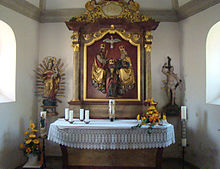Trinity Chapel (Kirchhausen)
The Trinity Chapel in the Heilbronn district of Kirchhausen dates back to a foundation from 1716 and is located southeast of the town center, near today's outdoor pool.
history
The Trinity Chapel in Kirchhausen was donated in 1716 by Johann Debatia, an assessor in Kirchhausen. Until 1838 it was the destination of processions on the Epiphany and later became a place of pilgrimage. The blood stone in front of the chapel was of particular importance.
description
architecture
The chapel is a simple, west-facing, single-storey hall building with a polygonal choir closure. The front is characterized by an arched door and two arched windows. Cornices are made of sandstone. The tiled roof is crowned by a small bell tower.
Furnishing
Inside the chapel there is a baroque altar with the plastic and colored depiction of the Coronation of the Virgin Mary, with sculptural figures of the Radiant Madonna and St. Sebastian is flanked. On the right side wall there are also old figures of saints showing St. Alban, St. Christopher and Anna with the youthful Maria. Figures of Saints Ulrich and Nicholas are attached to the opposite side wall, as well as a more recent painting showing a praying shepherd. The furnishings also include a holy water font from 1741.
An official description of Heilbronn from 1903 mentions a ceiling painting with scenes from the Revelation of John, which is no longer available today and which was painted by Anton Glassen from Hochhausen in 1892.
There are two wayside shrines in front of the chapel. The right wayside shrine with the colored relief depicting the blood miracle comes from the 18th century. The left wayside shrine shows a colored scene of the Mount of Olives in a neo-Gothic case.
literature
- Julius Fekete, Simon Haag, Adelheid Hanke, Daniela Naumann: Monument topography Baden-Württemberg . Volume I.5: Heilbronn district. Theiss, Stuttgart 2007, ISBN 978-3-8062-1988-3 . , P. 212.
Individual evidence
- ↑ “The chapel for healing. Trinity above the mill was donated by Joan Debatia, assessor in Kirchhausen († 1718), and visited in procession at the Epiphany until 1838; even today it is a place of pilgrimage. ” quoted from: Royal statistical-topographical office (ed.): Description of the Oberamt Heilbronn. Issued by the Royal Bureau of Statistics and Topography. Lindemann, Stuttgart 1868, p. 312. online at google-books
- ↑ State Statistical Office (ed.): "Description of the Oberamt Heilbronn." Kohlhammer Verlag, Stuttgart 1903. Volume II, p. 392
Web links
Coordinates: 49 ° 10 '52 " N , 9 ° 7' 12.9" E


